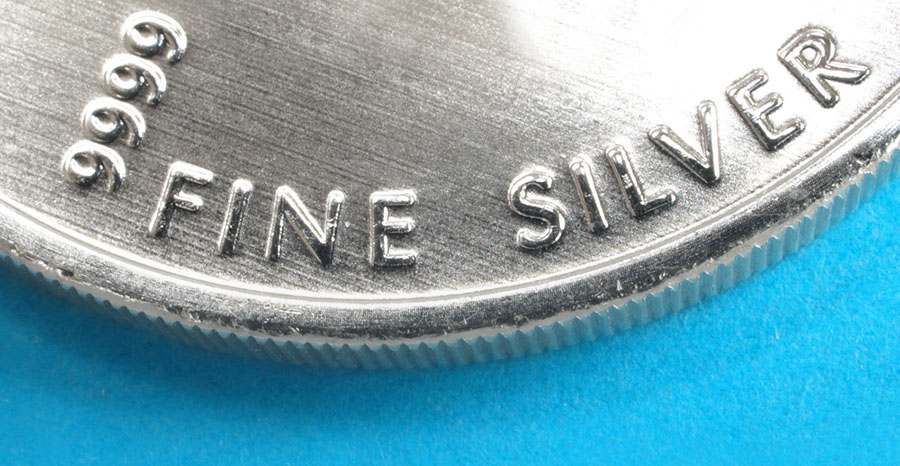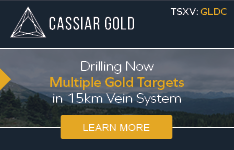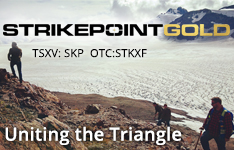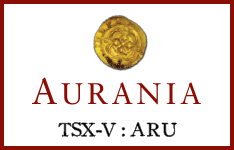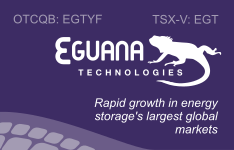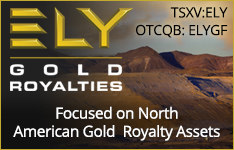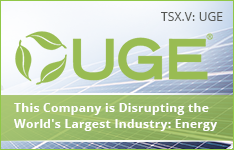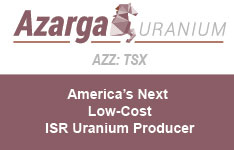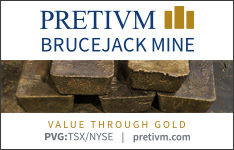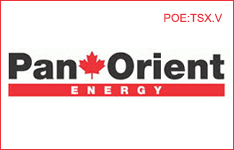Maurice Jackson: Today we will discuss the merits of owning government minted coins versus private minted coins. Joining us for conversation is Andy Schectman, the president of Miles Franklin Precious Metals Investments.
Glad to have you on the program to discuss an important topic for precious metals investors and in particular silver investors. But before we begin, sir, for first time readers, please introduce Miles Franklin Precious Metals Investments and the merits of becoming a client.
Andy Schectman: Miles Franklin is celebrating its 30th year in business this year. Since 1989 we've eclipsed $6 billion in transactions, and we've never had a customer complaint ever. We have never had a regulatory complaint. We maintain an A+ rating with the Better Business Bureau. We're one of fewer than 30 companies ever approved by the United States Mint as an authorized reseller. We have all sorts of exclusives in the storage space and just a great reputation, but really that doesn't mean very much to the State of Minnesota. The State of Minnesota is the only state in the United States to license and bond participants in the industry. So we are fully licensed, bonded, and background checked every single year, yourself included, myself included. And every employee at Miles Franklin has to be background checked and bonded. And what that really means above all else in a federally non-regulated industry is that the safety of the transaction is unparalleled, and the bonding alone has made over 95% of the industry boycott the State of Minnesota. It's from the ownership of a company, the bonding alone is enough to make them say, "I'll work in the other 49 states." Miles Franklin is very proud of our reputation in and of itself. The accreditation by the State of Minnesota makes doing business with us and with Maurice as safe of a transaction as possible in this industry.
Maurice Jackson: Let's begin today at the 30,000 foot level and define a term that is surrounded by a lot of ambiguity and that term is bullion. What is bullion? And how does this term apply to all precious metals?
Andy Schectman: Well, really bullion is anything from a bar or a round to a government issued coin. Bullion is a form of precious metals where the majority of the value is in the content of the metal, versus numismatics where the majority of the cost typically is in things associated with age and scarcity and rarity. As I hope to talk later on in this discussion, there is a melding of the two right now. But in general bullion is the majority of what you're directly related to the content or the value of the metal included in the coin or the bar.
Maurice Jackson: How about the term spot price?
Andy Schectman: Spot price is the price that the metal is trading at 24 hours a day around the globe changing every single second. It's just like watching a ticker on the Dow Jones Industrial Average, or the price of a barrel of oil. The spot price of gold is denominated typically in dollars world over and as the markets move around the globe is constantly being updated 24 hours a day, seven days a week.
Maurice Jackson: And what is the difference between the bid and the ask price?
Andy Schectman: The bid price is what someone will pay for an item. An ask price is what it will cost to buy the item from a company. So bid is sell back, ask is buy from.
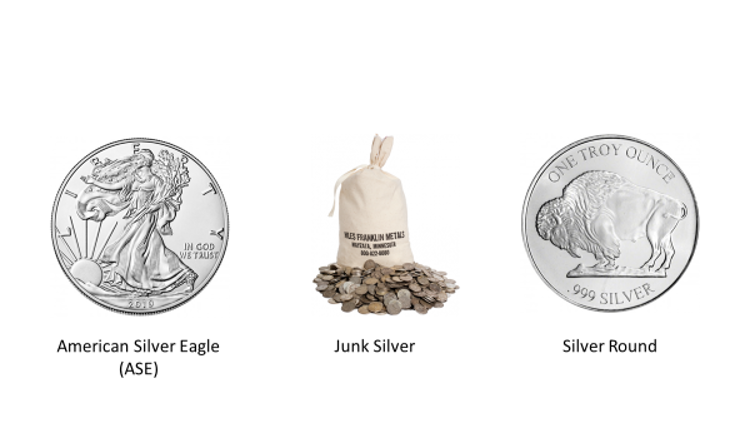
Maurice Jackson: I have displayed a U.S. Silver Eagle, junk silver and some silver rounds. Now there's a lot of ambiguity regarding these coins and how they fit into one's precious metals portfolio. Let me begin by asking what is a Silver Eagle? What is junk silver? And what is a silver round?
Andy Schectman: The Silver Eagle is the coin made by the United States Mint and has been made since 1986. It's I guess you'd call it the Cadillac of silver in the industry. Probably the most sought after form of silver, it's also the most expensive. The junk silver coins are dimes, quarters and half dollars minted prior to 1965. I think it gets a bad rap by the name of junk. Typically, it got that name because for many years dealers looked at it as difficult to accumulate and hold and store and bulky and oftentimes back when I started in this industry, I was able to acquire junk silver bags for under melt value and add 10, 15, cents an ounce and sell it for melt value or five or 10 cents over. I happen to think that the dimes and quarters and half dollars, otherwise known as junk silver or 90% silver by weight, is probably the best value penny-for-penny in silver right now.
And I've seen premiums in excess of $4.50 to $5 an ounce on junk silver and it really wasn't anything even remotely close to junk at that point. And in fact there was a time in 2007, 2008 and 2009 when the perceived threat of confiscation from President Obama grew and premiums on these coins were higher than that of Silver Canadian Maple Leafs, or Australian Kangaroos. So I like them because there hasn't been silver in our dimes and quarters since 1964, that was the last year that we saw it. From '65 to '69 they made 40% silver Kennedys but I really don't count those. So pre '65 dimes, quarters and half dollars, which can't be reproduced, to me is really the best value because A, it's the least expensive route right now and B, it can't be reproduced. C, it's the most flexible way of owning it in terms of a divisional or fractional form. It offers great utility and if things were ever to really get bad, I could see premiums on junk silver go parabolic. As far as one ounce rounds, Maurice, those are just one ounce coins that look very much like a Silver Eagle or a Gold Buffalo or a Saint Gaudens or whatever the design on that particular round is, but it's not made by a government, so it doesn't have a legal tender face value.
So really the difference is the face value that the government puts on the coin, which is rather meaningless in and of itself as the U.S. Silver Eagle has a $1 face value, but it's an ounce of silver. And the Canadian Maple Leaf has a $5 face value, but has an ounce of silver. So it's interesting that people who understand precious metals typically have some sort of an aversion to the economic policies of the governments that they reside under, yet very often prefer the government issued coins because of the stated purity, because of the government entity standing behind the authenticity. The bottom line is, as long as you're doing business from a reputable company, it doesn't matter what design is on the coin, whether it's a pre '65 dime or a Silver Buffalo Round made from a private refiner or an American Eagle.
The most important thing and in the end is it's the number of ounces that matter. I would simply say to me the biggest consideration is to not cross the penny wise pound foolish threshold. In other words, some people may want to buy a 100 ounce bar of silver made by the same type of refiner that makes the one ounce rounds in an effort to maximize his or her dollar. But in reality it's been my experience that whether you're playing poker with your friends, or driving on a crowded highway, or just investing, or living life, you can never have too many outs or too many options or too many exits. And so I think that in general when we talk about the larger items versus the three items that you mentioned, the savings in buying a 10 ounce bar or 100 ounce bar is not commensurate with the loss of flexibility.
I think the three items that you mentioned, and I would throw in the Canadian Maple Leaf, to me are the best or most preferred ways of accumulating and holding silver: recognizable, sought after, very liquid, non-subjective. And the biggest difference with the junk silver is its flexibility and utility. If things ever got really, really bad, 14 dimes minted prior to 1965 is almost an exact ounce of silver. So when you talk about the ability to trade or barter with, I've heard lots of stories in 1979 with the oil embargo and inflation running a up towards 17%, our interest rates and inflation going through the roof. A lot of gas stations across the country were accepting a silver dime for a gallon of gas. Now, back then with silver almost at $50 you're talking three and a half bucks melt value per silver dime. The gas stations were getting a good deal, but the moral of the story is when the currency in which you transact is inflating and becoming less desirable, the allure of having something very flexible in the form of junk silver to me is intriguing. And the fact that it can't be reproduced offers potential, premium potential that you won't find in any of the other items that we've mentioned.
Maurice Jackson: There are advantages and disadvantages to each of the silver products just referenced. And one of the most popular questions that we receive is which silver product is the best? And that's a personal decision. But Andy, you had an experience going through customs one day that helped me answer that question that I never considered and completely made me reposition my entire silver portfolio. Would you mind sharing your experience with us?
Andy Schectman: Yeah, sure. So, it's interesting, I've been telling people for a long time that it's the legal tender face value that matters as you're traveling. And really it's important to note too, Maurice, you need to know where you're traveling to. And I wouldn't recommend this type of a deal south of the border, but in and out of Canada, in and out of Western Europe, in and out of Australia, New Zealand or back into the United States, this is real and it's legal. I was coming back from Montreal, where we have a Brink's facility and I met one of my largest clients who asked me as a favor to bring back on the airplane with me 240 Gold Maple Leafs, as one of his associates was being transferred to the United States. And the associate, it was his gold, asked me to bring it back and to put it into one of our depositories here in the United States on his behalf.
And I acquiesced as this was a very substantial client of mine and I brought it back with me on the airplane. Now when you go through customs in any Canadian airport, you go through United States immigration and customs at that airport, so when you land in your point of destination, for me it was Minneapolis, you get off the plane and you go, you don't go through customs right there. So in any case, when I got up to the window, I have a Global Entry Card, which means I've met with Homeland Security and they vetted me in and gave me that card so they know who I am to a degree. I don't know if it shows that I own a precious metals company when I go through the line, but nonetheless, when I got up to the window, the gentleman asked me what I had because 240 times 50, the face value of a Canadian Maple Leaf is $12,000 and as you know, Maurice, on the customs form, it says, are you carrying over $10,000? I wrote that I did, and I said yes, and that's the only answer.
And when you get up to the window, they ask you, "What do you have as per that declaration?" And I said, "I have 240 Gold Maple Leafs. They're $50 face value coins, I'm declaring $12,000." And the gentleman wearing the United States Homeland Security garb said, "Well, that's beyond my pay grade. You're going to need to go to further screening." And he shut the light off of his booth and walked out from behind and escorted me down a 45 degree ramp into the basement of the Montreal Airport in a room roughly the size of a small auditorium that was 100% mirrors and stainless steel. He said to me, "Sit down. Don't touch your bag. Someone will be with you shortly." I sat in that room alone for almost 45 minutes. And you could feel them, whoever them was, looking at me through the mirrors, waiting for me to shove coins down my pants or whatever it was they thought I might do.
And when the Department of Homeland Security supervisor finally appeared from outside of one of these mirrors, or inside of one of these mirrors rather, he asked me what I had and I said to him, "Just as I told your associates, sir, I have 240 one ounce Gold Maple Leafs, so I'm declaring $12,000. And I showed them a coin and I said, "See, it's a $50 coin." And he said to me, "Mr. Schectman, I'm inclined to believe you, but I need to ask you a few questions." He said, "How much is the price of gold today?" And this was a couple of years ago, and I told them gold is $1,200 and he did the math in his head and he said, "Well, isn't that nearly $300,000?" I said, "Yes sir, it is." I said, "But listen, you could take this coin out into the lobby of the airport where there's a Tim Horton's. You could get a donut and a cup of coffee and now wouldn't be the smartest thing you ever did, but they would have to take it and accept it as legal tender. This is a $50 face value coin produced by the Royal Canadian Mint, it's legal tender.
So he says to me, "Well, I'm inclined to believe you, sir, but I'm going to borrow your coin and I'm going to do a little research. In the meantime you fill out this FENCIN form, and I'll be back in a few minutes. And he disappeared behind one of the mirrors again. Now, this FinCEN form is a form you never want to see. And the acronym is something to the extent of financial enforcement network criminal investigation, something to that degree. And the form is very invasive and something that you know is going on a desk where you don't ever want your social security on that desk.
And I was a little reticent at that point because this wasn't even my stuff. But anyways, I had no choice and this far down the rabbit hole, so I had to fill it out. It's a two page form and I filled it out and the gentleman came back and he said, "I'll be darned. You're right. It is legal tender. Here's your coin back." He said, "Let me see the FinCEN form." And I hand it to him and he says, "Oh, wait a second, I almost forgot how much money do you have on you?" And I opened up my wallet and I said, "I have $37 and a $5 Canadian bill." And he said, "Do you have any other money you want to tell me about, Mr. Schectman? And I said, "No, I don't." He says, "Are you sure?" And I said, "Geez, I might have some change in the bottom of my backpack."
I think a bead of sweat drip down my temple because I'm thinking, do I have something that I don't know about? Do I have some coins or some money in my bag? I didn't know. I said, "No, I have nothing. Honestly I don't." He says, "Okay, you're free to go." And he tears up the FinCEN form. And I said to him, "Listen, I don't mean to look a gift horse in the mouth. I have been sitting here for an hour and now you're letting me leave without declaration. Can you please explain?" And he says, "I had a feeling you'd ask me that question." And he says, "You're entering the United States with 37 US dollars, a $5 Canadian bill and some change in your backpack. Is that correct? I said, "Yes, sir. That's to the best of my knowledge, that is correct. He says, "You're also entering the United States with $12,000 Canadian legal tender in the form of 240 Canadian Maple Leaves, $50 face value. Is that correct?" "Yes sir." He said, "Well that exchange rate puts those at $9,400 in change. You're under the $10,000 threshold. You're free to go." And he let me leave.
He let me leave without any declaration whatsoever. Well, that was the second time I've done that. I did something similar to that in Vancouver the year before to test out what I've always told people. The bottom line is simply this, if you are going somewhere where you're not concerned about the customs, when you're traveling with legal tender gold and legal tender silver, it is the face value of said coins that customs will record. Now, if I were going through with Krugerrands or one ounce bars, that is a no-no. Krugerrands have no face value. One ounce bars are just an ounce of gold and the minute you get over $10,000 in value in bullion value, you would have to declare it.
So I guess the bottom line here is that the face value does matter as it pertains to travel. One interesting side note I've always often wondered what the IRS would say when we talk about, I think it's a $14,000 gift exclusion that each parent can give to a child. And I wonder what they would say about a US Eagle is a $50 coin too, giving 280 Gold Eagles to your child as a $14,000 gift exclusion. I don't know what they would say about that, but it's interesting when one hand of the government looks at it as legal tender and you wonder what the other side of the government feels about it if you were to challenge it. But nonetheless, I've had great experiences traveling across the border with legal tender gold as the face value and nothing else.
Maurice Jackson: What a compelling story. I remember when you shared that with me and I alluded to it earlier, how it changed my silver portfolio. I don't know if you recall when you shared that with me, but I immediately got rid of all of my rounds and my 100 ounce bars and I immediately got to Eagles. I think that was a very prudent move and I appreciate you sharing that with our audience members, because a lot of us aren't aware of that if we don't travel outside of the United States and or we don't have our bullion with us and if we did the advantages of having one versus the other. Switching gears here, from a price perspective, as you alluded to it earlier, using ratios, what are you sharing with your clients right now to purchase and why?
Andy Schectman: Well, I'd like to say on one hand I was wrong and on the other hand I think I'm going to be right. I was wrong at least so far in saying to people the ratio between platinum and palladium was so far out of whack they should trade their palladium to platinum. I look at the palladium market and the silver market and see great similarities. The palladium market has gotten so strong based upon lack of supply and huge institutional demand in the form of catalytics, that the traders have stopped trading it. The commercial banks have stopped manipulating it and what you see in the palladium market is a glimpse of what a real free market looks like. Palladium to me seems like a glimpse of what a free market looks like, where demand overwhelmed supply and the price goes parabolic.
The silver price and the ratio between silver and gold is ridiculously out of whack as much as it's been in a hundred-plus years. Only a few times in the last 100 years have we seen anything near this, nearly 90:1. That is absolutely crazy and I use the same phrase all the time, it's like four feet of snow in the Florida Keys. It's really unbelievable. When you talk to some of the most respected mining names, what they see coming out of the ground is closer to 9:1. Silver is found in the earth in a form called epithermal close to the surface. And so the big deposits were found many years ago. Most of what is mined nowadays is by-product mining from other metals. And so much of the silver that is used in industry and has been used for so many years has gone forever, never to be recaptured. It's in motherboards, in landfills. The ratio of 16:1 that we saw forever, the ratio of a 90:1 that we see right now is not right.
And the bottom line is simply this, at a nearly 90 to one ratio, it is an absolute gift. And I feel that way, not just because of the mathematics of it and how unusual that ratio is, but when you take a glimpse at the most sophisticated, well-funded, well-informed, and nefarious traders on the globe, JP Morgan, there may be close to a billion ounces accumulated of silver over the last 10 years, 12 years, according some of the silver experts that follow the silver fundamentals very closely. And they point out that they see the most sophisticated traders on the globe cornering the physical market of silver.
And at that level they have been holding down the paper price to create a perception of reality that has allowed them to scoop up all the physicals at ridiculously low prices. So the bottom line, silver is the most undervalued commodity on the planet. And I would challenge anyone to find a commodity that is trading for a third of its all-time high from 1980. There's nothing like it, and in and of itself, the fact that you're seeing such massive accumulation by the commercial banks, I think puts an exclamation point on how undervalued it is. And I think that should consider trading your gold for silver at these inflated ratio numbers with the expectation of trading back to gold when the ratio normalizes. For the last 150 years roughly, the average ratio between gold and silver has been 42:1, so we are past double.
The last time we saw our ratio about 80:1 was 2010, and one year later in 2011 you had $50 silver and $2,000 gold, 40:1. So the idea to me if someone wanted to capitalize on these ratios is not to move everything into silver because it's so undervalued, or because JP Morgan is cornering the market of physical, it's to do so realizing that the ratio or mathematical historical averages and ratios are there for a reason. And the further away you get from those long-term established averages, the greater the magnetism that pulls you back. Now, I was wrong with palladium. Palladium got way ahead of I think what anyone thought it would do and the traders gave up on it. I think you could see that with silver too. Huge, huge supply demand imbalances. And so I think you could see a point where silver starts to move so fast that the commercial banks get on the long side of it and let it run instead of trying to hold it back.
And the potential for silver I think is parabolic. Now if someone does trade their gold for silver, I would do it with the intention, however, of doubling the amount of gold I started with, just when the ratio comes back to its mean, to its average. You could trade 10 ounces of gold right now at 90:1 and into silver. And when silver falls or the ratio falls back to the 45:1 or 42:1, switch back to gold and double what you started with without paying a penny. That's the idea.
But I will simply say this, that logic and outcome sometimes are inversely correlated in this world. And palladium and platinum is a great example, because for the past 18 months I would have thought that trading palladium for platinum was such a great idea, because the 30 years before that, most of the time palladium was one third the price of platinum and right now it's three times the price of platinum. So there are a lot of imbalances right now and a lot of anomalies and the gold to silver ratio is one of them. The biggest of them all is palladium to platinum and I guess I would just say that palladium is an example of what I think silver could be and what gold could be. When the prices start to move on the upside and the commercial banks give up on trying to hold them back, you will very quickly see what a free market looks like.
Maurice Jackson: Andy, we referenced the buying opportunity before, since silver, and I want to get to gold because there is one buying opportunity within gold, but within silver, if I understand correctly, is the best value proposition you see within silver, junk silver?
Andy Schectman: It is. I really think there's nothing that compares to it. It's the least expensive. It can't be reproduced. It's the most flexible and it offers premium potential because of the fact that it can't be reproduced. You don't get that in rounds and in bars and to a lesser extent in government issued coins. For example, in any of the government issued gold coins, as you move down in denomination from one ounce, to one half ounce, to one quarter ounce, to one tenth ounce, you pay a higher premium. The mint charges more. If you buy a 100 ounce bar, you pay less than if you buy 100 one-ounce rounds. But here you get the greatest form of flexibility, plus a free call on I guess numismatic premiums not the right word, but a free call on scarcity premium. Whether or not happens is irrelevant. It's happened before, could happen again. But you get a free call on that and it's the least expensive route. To me, it's by far the best choice.
Maurice Jackson: And speaking of numismatic gold, we touched on that in previous interviews. What is the buying opportunity before us there?
Andy Schectman: The $10 and $20 gold pieces in Mint State 62, 63, 64 are the best value I've seen in gold in 30 years, Maurice. What is really strange is the fact that gold is at all- time highs in almost 80 currencies. It's at all-time highs or real close to in Canadian dollars in Aussie dollars, in the euro just last week, and most major currencies, I think with the exception of Swiss francs and the dollar, it's at all- time highs. The rest of the world understands the significance of precious metals. The central banks reclassification of gold as a tier one asset, and their enormous accumulation since 2018 shows that there is a huge demand for precious metals. I mean the price is up almost 30% since last January. But what's interesting about it is that in the United States, there are the lowest premiums across the board in gold and silver that I've seen in 30 years. Whether you're talking junk silver coins, whether you're talking Gold and Silver Eagles, secondary market Gold and Silver Eagles, or in this case numismatics.
You can buy certified uncirculated $20 gold pieces for less than you can a Gold Eagle. I have never seen that in 30 years ever. And so the reason people normally say don't buy numismatics is that the premiums are too high and you're paying more money for age and scarcity and collector premium than you are for the underlying content. Right now, for the first time in my 30-year career, that's not true. In fact, there is no opportunity cost. And when we talk about a free call on numismatic premium, I know we're talking about trading gold to silver as really the ultimate value play, but for people who want gold, in my entire career, I have never seen a better value ever than in the uncirculated $20 gold pieces. They were trading in 2007, 2008 and 2009, with $1,000 gold, they were trading as much as 60%, 70% premium above a $1,000 gold price, again with the threat or the perceived threat of confiscation from President Obama. All I can tell you is that I've done this for a very long time and they're trading at price levels I never ever thought I would see, the very finest value in gold that I've ever seen in 30 years.
Maurice Jackson: Andy, for someone who wants to take advantage of these buying opportunities, what's the best way for them to contact you?
Andy Schectman: Well, they can email me directly at [email protected].
or 800.255-1129.Maurice Jackson: And as a reminder, I'm the proud licensed representative for Miles Franklin Precious Metals Investments, where we provide a number of options to expand your precious metals portfolio, from physical delivery, offshore depositories, precious metal IRAs and private blockchain, distributed ledger technology.
Call me directly at 855-505-1900 or you may email [email protected]. Finally, we invite you to subscribe to www.provenandprobable.com. We provide Mining Insights and Bullion Sales. Andy Schectman of Miles Franklin Precious Metals Investments. Thank you for joining us today on Proven & Probable.
Maurice Jackson is the founder of Proven and Probable, a site that aims to enrich its subscribers through education in precious metals and junior mining companies that will enrich the world.
[NLINSERT]Disclosure:
1) Statements and opinions expressed are the opinions of Maurice Jackson and not of Streetwise Reports or its officers. Maurice Jackson is wholly responsible for the validity of the statements. Streetwise Reports was not involved in the content preparation. Maurice Jackson was not paid by Streetwise Reports LLC for this article. Streetwise Reports was not paid by the author to publish or syndicate this article.
2) This article does not constitute investment advice. Each reader is encouraged to consult with his or her individual financial professional and any action a reader takes as a result of information presented here is his or her own responsibility. By opening this page, each reader accepts and agrees to Streetwise Reports' terms of use and full legal disclaimer. This article is not a solicitation for investment. Streetwise Reports does not render general or specific investment advice and the information on Streetwise Reports should not be considered a recommendation to buy or sell any security. Streetwise Reports does not endorse or recommend the business, products, services or securities of any company mentioned on Streetwise Reports.
3) From time to time, Streetwise Reports LLC and its directors, officers, employees or members of their families, as well as persons interviewed for articles and interviews on the site, may have a long or short position in securities mentioned. Directors, officers, employees or members of their immediate families are prohibited from making purchases and/or sales of those securities in the open market or otherwise from the time of the interview or the decision to write an article until three business days after the publication of the interview or article. The foregoing prohibition does not apply to articles that in substance only restate previously published company releases.
Proven and Probable LLC receives financial compensation from its sponsors. The compensation is used is to fund both sponsor-specific activities and general report activities, website, and general and administrative costs. Sponsor-specific activities may include aggregating content and publishing that content on the Proven and Probable website, creating and maintaining company landing pages, interviewing key management, posting a banner/billboard, and/or issuing press releases. The fees also cover the costs for Proven and Probable to publish sector-specific information on our site, and also to create content by interviewing experts in the sector. Monthly sponsorship fees range from $1,000 to $4,000 per month. Proven and Probable LLC does accept stock for payment of sponsorship fees. Sponsor pages may be considered advertising for the purposes of 18 U.S.C. 1734.
The Information presented in Proven and Probable is provided for educational and informational purposes only, without any express or implied warranty of any kind, including warranties of accuracy, completeness, or fitness for any particular purpose. The Information contained in or provided from or through this forum is not intended to be and does not constitute financial advice, investment advice, trading advice or any other advice. The Information on this forum and provided from or through this forum is general in nature and is not specific to you the User or anyone else. You should not make any decision, financial, investments, trading or otherwise, based on any of the information presented on this forum without undertaking independent due diligence and consultation with a professional broker or competent financial advisor. You understand that you are using any and all Information available on or through this forum at your own risk.



